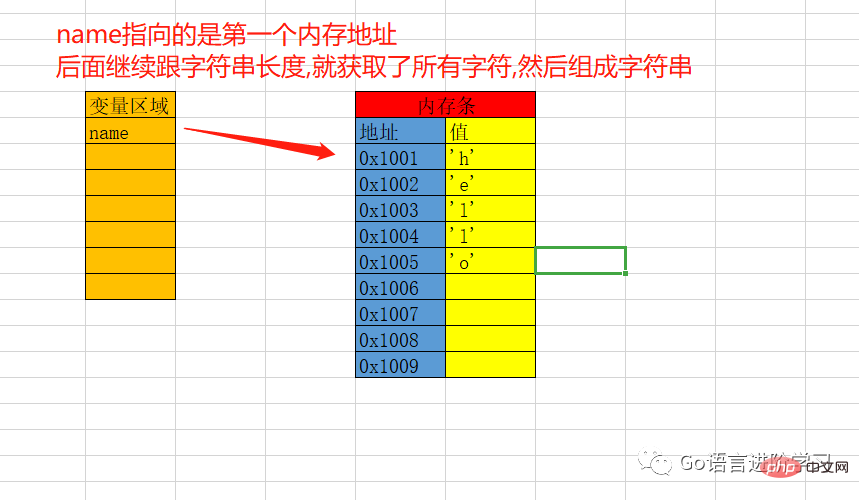Maison >développement back-end >Golang >Un article pour vous aider à comprendre les types de données de base du langage Go
Un article pour vous aider à comprendre les types de données de base du langage Go
- Go语言进阶学习avant
- 2023-07-20 15:47:31790parcourir
iota
是Go中的一个常量计数器,只能在跟常量(const)一块使用。
我们先来理解这一段话。
iota在const关键字出现时将被重置为0const中每新增一行常量,iota将计数(+1)一次
示例1:
package main
import "fmt"
func main() {
const (
n1 = iota //在const关键字出现时将被重置为0
n2 //没写相当于写了个n2=iota,每新增一行常量iota计数(+1)一次,n2 = 1
n3 //同上 n3 = 2
n4 // 同上 n4 = 3
)
fmt.Println(n1, n2, n3, n4)
}示例2:
遇到_会是什么情况。
package main
import "fmt"
func main() {
const (
n1 = iota //在const关键字出现时将被重置为0
n2 // n2=1
_ //匿名变量,相当于写了个 _=iota,所以此时iota=2
n4 //n4=3
)
fmt.Println(n1, n2, n4)
}示例3:
一行多个iota est un Constante
🎜Commençons par comprendre ce paragraphe. 🎜🎜
package main
import "fmt"
func main() {
const (
a, b = iota + 1, iota + 2 //在const关键字出现时,iota=0,并且两次赋值在同一行,iota没有做+1
c, d //同理,新增一行常量,常量个数为俩,仍然是一行,所以iota=1
//c, d = iota + 1, iota + 2 同上,此时iota=1,c=2,d=3
e, f // 同理,同上,e=3,f=4
)
fmt.Println(a, b, c, d, e, f)
}
🎜Exemple 1 :🎜🎜 🎜Exemple 2 :🎜package main
import "fmt"
func main() {
var a = 10 //定义一个十进制数
fmt.Printf("%T\n", a) //功能:打印变量类型,结果:默认为int类型,也叫int64
fmt.Printf("%d \n", a) //功能:十进制输出,结果:10
fmt.Printf("%b \n", a) //功能:二进制输出,结果:1010
fmt.Printf("%o \n", a) //功能:二进制输出,结果:12
var b = 0b1010011010 //定义一个二进制数1010011010,以0b开头
fmt.Printf("%d\n", b) //结果:666
var c = 077 //定义一个八进制数77
fmt.Printf("%d\n", c) //结果:63
var d = 0x42 //定义一个十六进制42
fmt.Printf("%d\n", d) //结果:66
}🎜
🎜package main
import "fmt"
func main() {
var a = 1.21 //默认为float64
fmt.Printf("%T\n", a) //结果:float64
fmt.Printf("%f\n",a)//功能:输出浮点型数,结果:1.210000
fmt.Printf("%.1f\n",a)//功能:输出浮点型数,保留小数点一位,其他忽略,结果:1.2
fmt.Printf("%.2f\n",a)//功能:输出浮点型数,保留小数点二位,其他忽略,结果:1.21
}🎜
🎜Exemple 3 :🎜
🎜
🎜Multiple sur une seule ligne🎜🎜iota code >🎜🎜. 🎜🎜<section class="code-snippet__fix code-snippet__js"><pre class="brush:php;toolbar:false;">package main
import "fmt"
func main() {
const (
a, b = iota + 1, iota + 2 //在const关键字出现时,iota=0,并且两次赋值在同一行,iota没有做+1
c, d //同理,新增一行常量,常量个数为俩,仍然是一行,所以iota=1
//c, d = iota + 1, iota + 2 同上,此时iota=1,c=2,d=3
e, f // 同理,同上,e=3,f=4
)
fmt.Println(a, b, c, d, e, f)
}</pre></section><h2 cid="n139" mdtype="heading"><br></h2>
<h2 cid="n139" mdtype="heading" style='break-after: avoid-page;break-inside: avoid;orphans: 4;font-size: 1.75em;margin-top: 1rem;margin-bottom: 1rem;font-weight: bold;line-height: 1.225;cursor: text;border-bottom: 1px solid rgb(238, 238, 238);white-space: pre-wrap;font-family: "Open Sans", "Clear Sans", "Helvetica Neue", Helvetica, Arial, sans-serif;text-align: start;'>
<span md-inline="plain">整型</span><br>
</h2>
<p cid="n140" mdtype="paragraph" style='line-height: inherit;orphans: 4;margin-top: 0.8em;margin-bottom: 0.8em;white-space: pre-wrap;font-family: "Open Sans", "Clear Sans", "Helvetica Neue", Helvetica, Arial, sans-serif;font-size: 16px;text-align: start;'><span md-inline="plain">整数,很简单了,就是像</span><span md-inline="code" spellcheck="false"><code style="font-family: var(--monospace);vertical-align: initial;border-width: 1px;border-style: solid;border-color: rgb(231, 234, 237);background-color: rgb(243, 244, 244);border-radius: 3px;padding-right: 2px;padding-left: 2px;font-size: 0.9em;">1,2,3,7,11,..这样的整型数字了。
但是在Go中,整数分为两大类,正整数和没有符号的整数。
u开头的不能存负数
uint8uint16 |
无符号 16位整型 (0 到 65535) |
|---|---|
无符号 32位整型 (0 到 4294967295)uint8
|
无符号 8位整型 (0 到 255) |
uint16 |
无符号 16位整型 (0 到 65535) |
uint32 | |
uint64uint64 |
无符号 64位整型 (0 到 18446744073709551615) |
int8 |
有符号 8位整型 (-128 到 127) |
int16 |
有符号 16位整型 (-32768 到 32767) |
int32 |
无符号 64位整型 (0 到 18446744073709551615) |
int64 |
Entier 64 bits signé (-9223372036854775808 à 9223372036854775807) |
Différences sur différentes plateformes.
uint<span md-inline="code" spellcheck="false" style="box-sizing: border-box;"><code style="box-sizing: border-box;font-family: var(--monospace);text-align: left;vertical-align: initial;border-width: 1px;border-style: solid;border -couleur : RVB (231, 234, 237) ; couleur d'arrière-plan : RVB (243, 244, 244) ; rayon de bordure : 3 px ; remplissage à droite : 2 px ; remplissage à gauche : 2 px ; ">int32int32,64位操作系统上就是int64 | ||
|---|---|---|
uintptr,64位操作系统上就是 |
uintptr |
示例:
package main
import "fmt"
func main() {
var a = 10 //定义一个十进制数
fmt.Printf("%T\n", a) //功能:打印变量类型,结果:默认为int类型,也叫int64
fmt.Printf("%d \n", a) //功能:十进制输出,结果:10
fmt.Printf("%b \n", a) //功能:二进制输出,结果:1010
fmt.Printf("%o \n", a) //功能:二进制输出,结果:12
var b = 0b1010011010 //定义一个二进制数1010011010,以0b开头
fmt.Printf("%d\n", b) //结果:666
var c = 077 //定义一个八进制数77
fmt.Printf("%d\n", c) //结果:63
var d = 0x42 //定义一个十六进制42
fmt.Printf("%d\n", d) //结果:66
}
浮点型
在Go中,只有float32和float64,默认使用的是float64。
示例:
package main
import "fmt"
func main() {
var a = 1.21 //默认为float64
fmt.Printf("%T\n", a) //结果:float64
fmt.Printf("%f\n",a)//功能:输出浮点型数,结果:1.210000
fmt.Printf("%.1f\n",a)//功能:输出浮点型数,保留小数点一位,其他忽略,结果:1.2
fmt.Printf("%.2f\n",a)//功能:输出浮点型数,保留小数点二位,其他忽略,结果:1.21
}
布尔值
在Go中,bool类型就俩值,true和false。
无示例。
注:
bool类型默认值为false。true != 1,在Go中,bool类型和整型不能混用。
字符串
终于到字符串了,在Go中,字符串是基本数据类型,在栈中存储。
字符串的值为双引号("")中的内容。
示例:
package main
import "fmt"
func main() {
var name = "hello"
var name2 = "张三"
fmt.Println(name,name2)
}在Go中,字符串内存布局如下。

En fait, dans Go, l'essence d'une chaîne est d'assembler les caractères un par un.
Chaîne multi-lignes
Parfois, nous pouvons avoir besoin d'un long article et d'une longue chaîne, nous devons alors utiliser le numéro `.
package main
import "fmt"
func main() {
var lyric = `
昨夜同门云集bai 推杯又换盏
今朝du茶凉酒寒 豪言成笑谈
半生累 尽徒然zhi 碑文完美有谁看dao
隐居山水之间 誓与浮名散
湖畔青石板上 一把油纸伞
`
fmt.Println(lyric)
}
字符串常用操作
len(str)
+或fmt.Sprintf
| strings.Split
|
|---|---|
分割len(str) |
求长度 |
+或fmt.Sprintf |
拼接字符串 |
strings.Split | |
strings.containsstrings.contains |
判断是否包含 |
strings.HasPrefix,strings.HasSuffix |
前缀/后缀判断 |
strings.Index(),strings.LastIndex() |
子串出现的位置 |
strings.Join(a[]string, sep string) |
判断是否包含 |
strings.Index(),strings.LastIndex()🎜🎜🎜🎜🎜子串出现的位置🎜🎜🎜🎜
